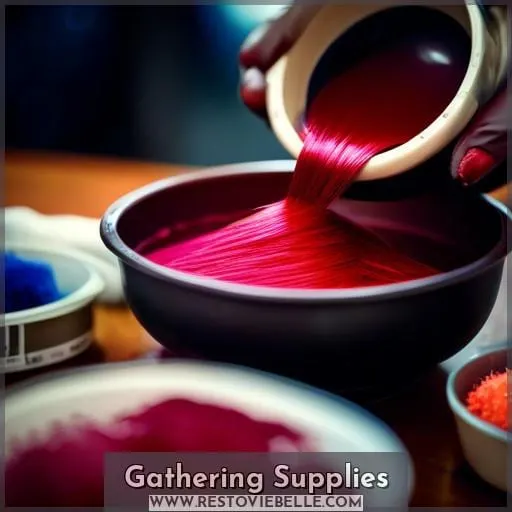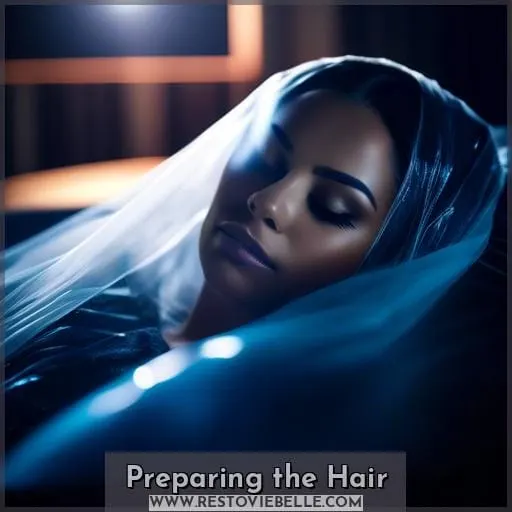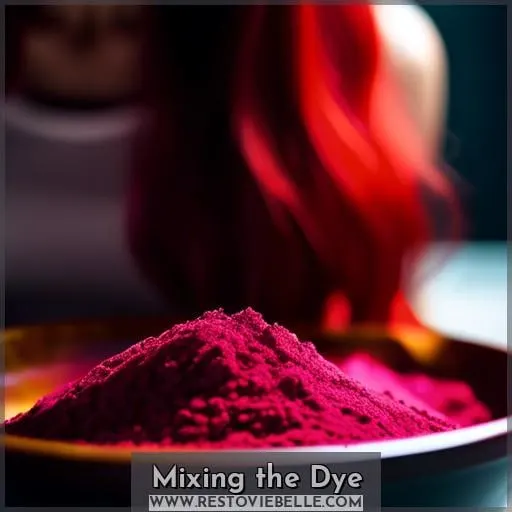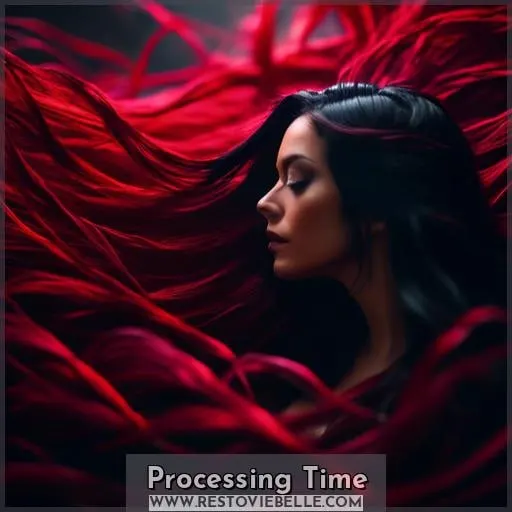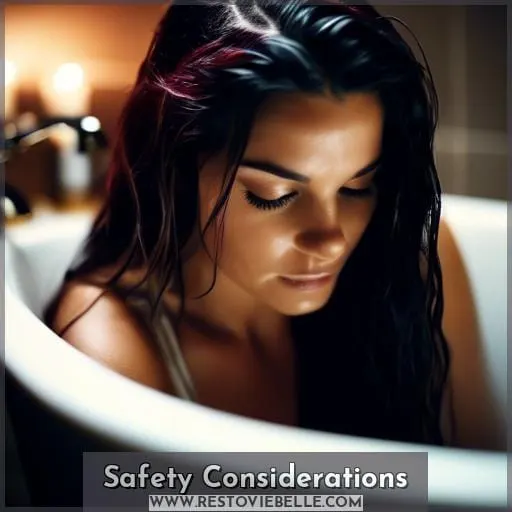This site is supported by our readers. We may earn a commission, at no cost to you, if you purchase through links.
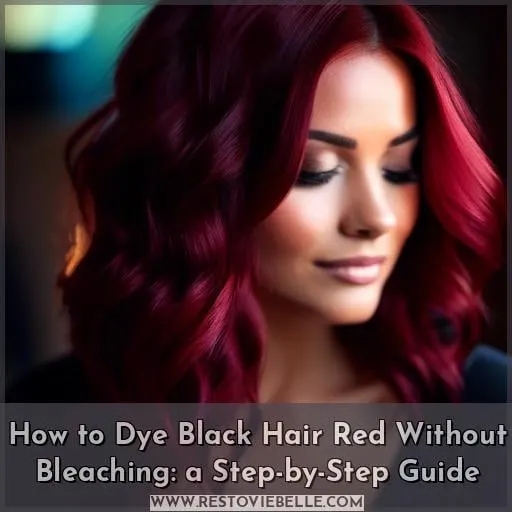 Diving into the world of hair color, you’re about to embark on a vibrant transformation from black to red without the harshness of bleaching.
Diving into the world of hair color, you’re about to embark on a vibrant transformation from black to red without the harshness of bleaching.
Understanding the chemistry of hair and dyes is crucial; it’s not just about changing shades but also about maintaining the integrity of your hair.
With the right hue that complements your skin tone and a careful selection of supplies, you’ll achieve a stunning red that defies the norm, all while keeping your hair’s health in check.
Get ready to flaunt a bold, red mane that’s all about freedom and innovation, without compromising on your hair’s well-being.
Yes, you can dye black hair red without bleaching by using high-lift dyes or semi-permanent dyes designed for dark hair, such as Splat Midnight Ruby or L’Oreal Highcolor in magenta with a 30 volume developer.
These products are formulated to deposit color on darker hair shades without the need for pre-lightening.
Table Of Contents
- Key Takeaways
- Choosing the Right Hue
- Gathering Supplies
- Preparing the Hair
- Mixing the Dye
- Application Technique
- Processing Time
- Rinsing and Conditioning
- Aftercare and Maintenance
- Safety Considerations
- Frequently Asked Questions (FAQs)
- How does the water hardness or mineral content in my area affect the final color of red dye on black hair?
- Can dietary changes or supplements enhance the vibrancy or longevity of red-dyed hair?
- What are the environmental factors, such as sun exposure or chlorine, that can cause red dye to fade faster, and how can I protect my hair from them?
- How does the texture and porosity of my hair affect the uptake and fading of red dye, and are there specific products recommended for different hair types?
- Can the use of styling tools (straighteners, curling irons) alter the shade of red over time, and what protective measures should be taken to maintain the color?
- Conclusion
Key Takeaways
- Opt for high-lift or semi-permanent dyes specifically designed for dark hair, such as L’Oréal Paris Excellence HiColor Red Magenta Highlights or Splat Midnight Ruby, to achieve red hues without the need for bleaching.
- Select red hair dyes based on your skin’s undertone: copper-based reds for warm undertones, blue-based reds for cool undertones, and purple-based reds for unique, standout hues.
- Prepare your hair and protect your skin before dye application by brushing to remove tangles, applying Vaseline around the hairline, ears, and neck, and sectioning hair into four parts for easier application.
- Use a high-quality dye and a level 30 crème developer for dark hair, ensuring to mix according to instructions and apply starting at the roots for full coverage and to avoid patchiness.
Choosing the Right Hue
Choosing the right hue for dyeing black hair red without bleaching involves careful consideration of your skin tone and the red undertones that will complement it best.
It’s crucial to understand that red hair colors come with various undertones—copper, blue, or purple—that can significantly affect how the color looks on you.
Selecting a shade that harmonizes with your skin’s undertones, whether warm or cool, will ensure the red enhances your natural complexion rather than clashing with it.
Skin Tone Considerations
Choosing the right hue for dyeing black hair red without bleach involves careful consideration of your skin tone and the seasonal trends.
For a successful color transformation that maintains hair health, it’s essential to select a red hair dye that complements your natural undertones. If you have cool undertones, opt for reds with a blue base like red velvet or aubergine red.
Always prioritize hair health by avoiding harsh chemicals and using products that protect and nourish your hair post-dyeing. Regular aftercare with color-safe products will help maintain the vibrancy of your red hair and keep it looking fresh.
Understanding Red Undertones
When diving into the world of red hair, understanding the undertones of the dye you choose is crucial, especially when working with black hair without bleaching.
Reds can be categorized based on their base tones: copper, blue, or purple. Each base interacts differently with your natural hair color and skin undertones, influencing the final outcome.
For those with warm skin undertones, a copper-based red offers a vibrant, fiery look that complements the natural warmth of your complexion. On the other hand, cool skin tones are flattered by blue-based reds, such as red velvet or aubergine, which provide a rich, deep color contrast.
Purple-based reds, like magenta from L’Oréal Excellence HiColor for dark hair, offer a unique hue that stands out, especially when used with a level 30 crème developer to lift the dark base without the need for bleach.
This approach allows for a significant transformation, achieving a striking red shade on black hair, while minimizing damage and maintaining hair health.
Gathering Supplies
Before you start transforming your black hair to a radiant red without the harshness of bleach, you’ll need to carefully select your dye and developer.
It’s essential to choose a high-quality red hair dye that’s formulated for dark hair, like the L’Oréal Paris Excellence HiColor Red Magenta Highlights.
Pair this with the right volume of developer to achieve the desired lift, and don’t forget to protect your hands with durable gloves such as the Blackwork Latex Gloves.
Dye and Developer Selection
After considering your skin tone and the red hue that best complements it, the next step is selecting the right dye and developer. For those aiming to transform dark hair to a vibrant red without bleaching, it’s crucial to choose products designed specifically for dark bases.
L’Oréal Excellence HiColor for Dark Hair is a prime example, capable of lifting dark hair up to 3-4 levels to achieve intense red tones. This product is formulated to minimize hair damage while delivering long-lasting color.
When it comes to developer strength, a level 30 crème developer is often the sweet spot. It provides enough lift to brighten dark hair without the harsh effects of higher volumes. Mixing the dye and developer according to the product instructions is essential for achieving the desired color while keeping hair damage to a minimum.
Choosing the right products and following a careful application process allows for a stunning red transformation without compromising hair health.
Protective Gear and Tools
When transitioning from dark to vibrant red hair without bleach, selecting the right protective gear and tools is crucial for a successful and safe dyeing process. Opt for a professional hair coloring kit like the ATB 3-piece set, which includes a mixing bowl and application brush designed for precise and easy application.
The bowl’s stability and the brush’s durable bristles ensure an even and thorough application, minimizing the risk of uneven color or damage to the hair.
Equally important is the choice of gloves. Nitrile disposable gloves are recommended for their resistance to the chemicals in hair dye, offering superior protection compared to other materials. These gloves prevent skin irritation and ensure that your hands remain clean and dye-free throughout the process.
Vaseline’s versatility as a protective barrier can’t be overstated. Applying a thin layer around your hairline, ears, and neck will guard your skin against dye stains, making cleanup much easier. Additionally, using a disposable plastic shower cap can help maintain the dye’s moisture and warmth during the processing time, enhancing the color’s intensity without the need for bleach.
In summary, the right tools and protective measures are essential for dyeing black hair red without bleach. They not only ensure a vibrant and even color but also protect your skin and hair from potential damage.
Preparing the Hair
Before you embark on the journey of transforming your black hair to a vibrant red without the use of bleach, it’s crucial to prepare your hair properly to ensure the best possible outcome.
Start by thoroughly brushing your hair to remove any tangles, which will make the application process smoother and more even.
Next, apply a thin layer of Vaseline around your hairline, ears, and neck to protect your skin from staining. This step is essential as it creates a barrier, preventing the dye from adhering to your skin while not affecting the dye’s ability to penetrate your hair.
Finally, section your hair into four parts to manage the dye application more efficiently, ensuring full coverage and minimizing the risk of missing any spots.
This preparation phase sets the foundation for a successful color transformation, allowing the dye to work its magic on your hair without compromising its health or your skin’s safety.
Brushing and Sectioning
To dye black hair red without bleaching, it’s crucial to prepare your hair properly to ensure the best possible outcome.
- Brush and Section Your Hair: Begin by thoroughly detangling your hair to prevent snags and ensure even dye application. Use a wide-tooth comb for hair detangling, minimizing hair breakage and promoting hair growth.
- Apply Vaseline: Protect your skin from dye stains by applying Vaseline around your hairline, ears, and neck. This step is essential for those concerned about skin sensitivity and dye irritation.
- Understand Your Hair’s Needs: Consider your hair’s porosity before starting. High porosity hair absorbs color quickly but also loses it fast, leading to rapid color fade. A pre-dye treatment can help manage hair porosity, ensuring your color lasts longer and looks vibrant.
By following these steps, you’re setting the stage for a successful dyeing process that respects your hair’s health and hydration needs.
Applying Vaseline
After brushing and sectioning your hair, it’s crucial to apply Vaseline around your hairline, neck, and ears. This step ensures your skin is shielded from potential dye stains and irritation. Vaseline acts as a barrier, offering protection and minimizing skin irritation during the dyeing process.
| Vaseline Benefits | Protection Areas |
|---|---|
| Minimizes skin irritation | Scalp |
| Prevents dye stains | Neck |
| Acts as a barrier | Ears |
| Enhances comfort | Surrounding skin |
Mixing the Dye
After preparing your hair, it’s time to focus on the crucial step of mixing the dye. This process isn’t just about combining two substances; it’s a precise science that ensures the color you desire is the color you get.
Start by selecting the right dye consistency and developer strength. The developer, often containing hydrogen peroxide, opens up the hair cuticle to allow the dye to penetrate deeply. The strength of the developer, measured in volume, determines how much lift or lightening you’ll achieve.
For dark hair aiming for vibrant reds without bleaching, a higher volume like 30 may be necessary.
Pre-testing the dye on a small hair strand is essential. This not only gives you a sneak peek of the final color but also ensures ingredient safety, especially if you have sensitive skin or allergies. Mix the dye and developer in a non-metal bowl to avoid any chemical reaction that metal might cause.
The mixing duration is critical; blend until you achieve a smooth, lump-free mixture.
Application Technique
When dyeing black hair red without bleaching, it’s crucial to start with a high-quality dye formulated for dark hair, like L’Oreal Excellence HiColor for dark hair.
Apply the dye beginning at the roots and ensure each strand is fully saturated to avoid patchiness and achieve full coverage. This method minimizes damage compared to bleaching, as the dye is designed to work with your natural hair color to produce the desired red tone.
Starting at the Roots
When starting at the roots, employ root application methods that ensure even saturation and color balance adjustment.
Mix your dye and developer as per the instructions, then begin applying at the roots, using thin sections for thorough saturation techniques.
It’s crucial to apply the dye evenly to avoid patchiness and achieve a seamless root color blending.
Allow the dye to process for the recommended dye processing duration, typically around 30 minutes, to ensure the color fully develops.
After processing, rinse thoroughly to reveal a vibrant, evenly colored mane.
Ensuring Full Coverage
To achieve full coverage when dyeing black hair red without bleaching, it’s crucial to meticulously apply the dye to avoid uneven color and potential hair damage.
- Start at the roots and apply dye evenly, avoiding skin sensitivity and staining prevention by using Vaseline as a barrier.
- Saturate each strand from root to tip to prevent patchiness and respect the red undertones that will emerge.
- Use the right dye selection, considering the hair’s condition to minimize hair damage.
- Work systematically through each section, ensuring no strand is missed for a uniform color.
Dyeing hair can still cause damage, so it’s important to use products that are gentle on the hair and to follow up with proper aftercare to maintain hair health and color vibrancy.
Processing Time
After meticulously applying the dye to your hair, the next critical step is the processing time. This phase is when the dye’s chemicals work to deposit color into the hair shaft. For red dyes, especially those designed for dark hair like L’Oreal Excellence HiColor, the recommended processing time is usually around 30 minutes.
However, this can vary based on the product instructions and your hair’s condition.
During processing, the dye interacts with the hair’s natural pigment and structure. The developer, often a level 30 crème for dark hair, opens the hair cuticle so the color molecules can penetrate deeply.
It’s essential to adhere to the recommended time to achieve the desired shade without over-processing, which can lead to damage.
Keep in mind that root touch-ups and color fading will require upkeep. The frequency of this maintenance depends on several factors, including how quickly your hair grows, the vibrancy of the red shade, and your budget considerations.
Red hair color is known for its tendency to fade, so plan for touch-ups every 4 to 6 weeks to maintain the intensity of the color.
Rinsing and Conditioning
After you’ve applied the red dye to your black hair without bleaching, it’s crucial to rinse and condition properly to maintain the vibrancy and health of your new color.
Once the processing time is complete, rinse your hair with warm water until the water runs clear, indicating that the excess dye has been washed out. Follow this with a deep conditioning treatment, which is essential for replenishing moisture and protecting your hair from potential damage caused by the dyeing process.
Regular use of color-safe shampoo and conditioner will help preserve the red tone and keep your hair looking bright and healthy.
Washing Out the Dye
After the dye has processed, it’s time for rinsing techniques that ensure color longevity and protect your scalp.
Start by rinsing your hair with lukewarm water to remove any dye residue without shocking your hair cuticles. This step is crucial for maintaining the vibrancy of your new red hue and preventing unnecessary scalp irritation.
Post-dye care involves using a color-safe shampoo and conditioner to cleanse gently while preserving the dye’s intensity. Deep conditioning treatments are also recommended to repair any potential damage from the dyeing process and to keep your hair healthy and the color rich.
Deep Conditioning
After dyeing your black hair red without bleaching, deep conditioning is a crucial step to ensure your hair remains healthy and vibrant. Deep conditioning treatments penetrate deeper into the hair shaft, providing much-needed moisture and protein to strengthen the hair cuticle.
This process is especially important after coloring, as it helps to repair and protect hair from damage caused by the dyeing process.
Here are some key points to consider for deep conditioning:
- Benefits of Deep Conditioning: Regular deep conditioning can prevent breakage, improve hair elasticity, and restore natural shine to your hair.
- Product Recommendations: Look for deep conditioners with natural ingredients and those that are specifically formulated for color-treated hair to maintain the vibrancy of your red hue.
- Frequency of Deep Conditioning: Depending on your hair type and condition, you may need to deep condition once a week or more frequently. Pay attention to how your hair responds and adjust accordingly.
Remember to allow sufficient time for the deep conditioner to work, typically 15 to 30 minutes, and consider using a hot oil treatment occasionally for an extra boost of nourishment.
Aftercare and Maintenance
After dyeing your black hair red without bleaching, it’s crucial to maintain the vibrancy and health of your new color.
Regular deep conditioning is key to keeping your hair moisturized and the red tones bright. This step helps to repair any damage from the dyeing process and can also assist in prolonging the life of your color, ensuring your red hair stays as vivid and glossy as possible.
Regular Deep Conditioning
After rinsing out the dye, it’s crucial to maintain the health of your newly colored hair with regular deep conditioning. Deep conditioning replenishes moisture and protein, which can be stripped during the dyeing process, and helps to maintain hair elasticity, preventing breakage.
It’s especially important for color-treated hair to receive this care to keep it vibrant and healthy.
Here’s a table summarizing the key aspects of deep conditioning:
| Benefits of Deep Conditioning | Frequency of Deep Conditioning | Deep Conditioning Ingredients |
|---|---|---|
| Prevents breakage and split ends | Once a week for damaged hair | Hydrolyzed proteins, natural oils |
| Restores natural shine | Every two weeks for healthy hair | Shea butter, coconut oil |
| Maintains hair elasticity | Adjust based on hair condition | Glycerin, honey |
| Supports color-treated hair | Monthly for colored hair | Amino acids, vitamins |
| Adds moisture and repairs damage | As needed for lifestyle changes | Avocado oil, aloe vera |
For DIY deep conditioning, you can create mixtures using common kitchen ingredients like mayonnaise, eggs, and olive oil, which can be just as effective as commercial deep conditioning products. When selecting a commercial product, look for one with nourishing ingredients that avoid harsh chemicals like sulfates and parabens.
Safety Considerations
When dyeing black hair red without bleaching, it’s crucial to prioritize safety and minimize potential damage.
Always perform a skin sensitivity test to ensure you don’t have an allergic reaction to the dye.
To prevent stains and mess, protect your skin and surroundings by applying Vaseline around your hairline and wearing old clothes or a cape.
Skin Sensitivity Test
Before you embark on transforming your black hair to a radiant red without bleaching, it’s crucial to conduct a sensitivity test to prevent allergic reactions or skin irritation.
Sensitivity testing, also known as patch testing, is a protective measure that can reveal potential allergic reactions to hair dye ingredients. Apply a small amount of the dye mixture to an inconspicuous area of your skin, such as behind the ear or the inner elbow, and wait 48 hours.
If you experience any signs of skin irritation, such as redness, itching, or swelling, don’t proceed with dyeing your hair, as these are indicators of an allergic reaction. Always prioritize your safety and consider consulting a professional if you’re unsure about the process.
Preventing Stains and Mess
When dyeing black hair red without bleaching, it’s crucial to prevent stains and mess, ensuring a clean, professional finish.
Start by donning protective gear like nitrile gloves, which are best for safeguarding against the chemicals in hair dye. Cover your work surface and wear old clothing to protect against accidental spills.
Applying Vaseline around your hairline, ears, and neck can act as a barrier to prevent skin staining. Ensure the room is well-ventilated to avoid inhaling fumes, which can be harmful or cause discomfort.
By taking these precautions, you maintain control over the dyeing process, minimize cleanup, and protect your skin and surroundings from dye stains, embodying innovation and freedom in your hair transformation journey.
Frequently Asked Questions (FAQs)
How does the water hardness or mineral content in my area affect the final color of red dye on black hair?
Hard water, with high mineral content like calcium and magnesium, can leave a film on hair that blocks color absorption.
Can dietary changes or supplements enhance the vibrancy or longevity of red-dyed hair?
Yes, dietary changes and supplements can indeed enhance the vibrancy and longevity of red-dyed hair.
Just as a well-nourished garden blooms more brightly, feeding your body with the right nutrients can turn your hair into a vibrant canvas.
Incorporating foods rich in antioxidants, vitamins, and minerals supports hair health from the inside out, making colors more vivid and lasting.
Supplements targeting hair health, such as those containing biotin, zinc, and vitamins A and C, can further bolster this effect, ensuring your fiery locks remain as luminous as a sunset for longer.
What are the environmental factors, such as sun exposure or chlorine, that can cause red dye to fade faster, and how can I protect my hair from them?
Sun exposure and chlorine can cause red dye to fade quickly.
Protect your hair by wearing a hat, using UV-protectant products, and rinsing hair before and after swimming to reduce chlorine damage.
How does the texture and porosity of my hair affect the uptake and fading of red dye, and are there specific products recommended for different hair types?
Your hair’s texture and porosity are like the canvas for your red dye masterpiece, influencing how the color clings and fades over time.
Imagine your strands as thirsty sponges: if they’re parched (high porosity), they’ll soak up the dye quickly but might let it slip away just as fast, leaving your vibrant red to fade into a whisper. On the flip side, strands that are less porous (low porosity) are like sleek, sealed tubes, challenging for the dye to penetrate but once in, the color holds on tight.
For those with high porosity, think of using products that seal and smooth, like a knight’s armor protecting a castle, to keep that red fiery. Low porosity warriors might need a gentle nudge, a softening of their defenses, to let the red in.
No matter your hair’s character, there’s a potion out there to make your red vivid and lasting.
Can the use of styling tools (straighteners, curling irons) alter the shade of red over time, and what protective measures should be taken to maintain the color?
Using styling tools like straighteners and curling irons can indeed alter the shade of red hair over time, causing it to fade.
To maintain the color, always use a heat protectant spray and opt for the lowest heat settings.
Additionally, consider minimizing the use of these tools to preserve your vibrant red hue.
Conclusion
Imagine transforming your black hair into a radiant red, much like the fiery hues of a sunset, without the damage of bleaching.
By carefully selecting the right dye and meticulously following the steps outlined, you’ve now unlocked the secret to a bold, red mane.
Remember to maintain your vibrant color with regular deep conditioning and a touch-up routine.
Embrace your new look with confidence, knowing you’ve mastered how to dye black hair red without bleaching.


